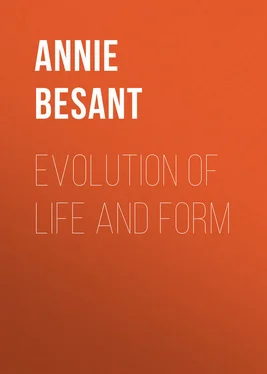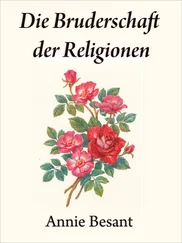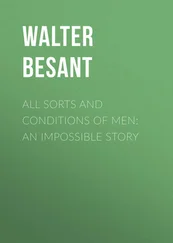Annie Besant - Evolution of Life and Form
Здесь есть возможность читать онлайн «Annie Besant - Evolution of Life and Form» — ознакомительный отрывок электронной книги совершенно бесплатно, а после прочтения отрывка купить полную версию. В некоторых случаях можно слушать аудио, скачать через торрент в формате fb2 и присутствует краткое содержание. Жанр: foreign_antique, foreign_prose, на английском языке. Описание произведения, (предисловие) а так же отзывы посетителей доступны на портале библиотеки ЛибКат.
- Название:Evolution of Life and Form
- Автор:
- Жанр:
- Год:неизвестен
- ISBN:нет данных
- Рейтинг книги:4 / 5. Голосов: 1
-
Избранное:Добавить в избранное
- Отзывы:
-
Ваша оценка:
- 80
- 1
- 2
- 3
- 4
- 5
Evolution of Life and Form: краткое содержание, описание и аннотация
Предлагаем к чтению аннотацию, описание, краткое содержание или предисловие (зависит от того, что написал сам автор книги «Evolution of Life and Form»). Если вы не нашли необходимую информацию о книге — напишите в комментариях, мы постараемся отыскать её.
Evolution of Life and Form — читать онлайн ознакомительный отрывок
Ниже представлен текст книги, разбитый по страницам. Система сохранения места последней прочитанной страницы, позволяет с удобством читать онлайн бесплатно книгу «Evolution of Life and Form», без необходимости каждый раз заново искать на чём Вы остановились. Поставьте закладку, и сможете в любой момент перейти на страницу, на которой закончили чтение.
Интервал:
Закладка:
Such is the great change. Let us now examine in detail. The fundamental difference between ancient and modern science is that ancient science studies the world from the standpoint of life which is evolving, while modern science studies the world by observing the forms through which that life is manifesting. The first studies life, and sees in forms the expressions of life. The second studies forms, and tries, by the process of induction, to find out if there be an underlying principle by which the multiplicity of forms may be explained. The first works from above downwards, the second from below upwards, and in that very fact is the promise of a meeting place where the two will join hand in hand. But this fundamental difference carries with it very important results. If we are to study the world from the standpoint of forms, our study will be almost endless in its multiplicity. Think of a tree; the one trunk through which the life is pouring, innumerable leaves in which that life is ultimately expressed; it is an image of the tree of life, that great Ashvattha, the tree of which we have heard, whose roots are in the heavens and whose branches spread out over the earth. If we are to study it where its trunk is, the trunk of life, we have the unity of purpose and can trace why we have multiplicity of forms; but if we are to start at the parts where the leaves are growing, leaf by leaf we must examine, every difference of outline we must record, each little variety in shape we must carefully note and study. Science studies the leaves in modern days – the old science studied the life. There is the fundamental difference. There is also the reason of the difference of methods by which the study must be carried on. What is the method of modern science? The use of clear observation, keen judgment, power of placing like things together, and seeing the differences that divide the classes of the like from the classes of the unlike. But in order that this may be done, inasmuch as nature is infinite both in the vast and in the minute, man demands, to supplement his limited senses, instruments and apparatus of the most exquisite and delicate character; so that it has been even said that the progress of science is the progress of the exquisite nature of the apparatus which science uses, and scientific men will devise a more delicate balance, a more dainty way of adjustment, instrument after instrument, until perfection seems well-nigh to be reached; the modern man of science, to carry on his researches, demands a vast array of apparatus that he must use for his work, for according to the delicacy of his apparatus is the extent of his observation of the forms to which his attention is directed. But the man of science of the ancient type does not ask for instruments; he is not studying the evolution of forms; he has to study life, not form; and for such study he must evolve himself, the life that is within him, for only life can measure life, only life can respond to the vibrations of the living; his work is to unfold himself, to bring out of the depths of his own nature the divine powers that lie hidden therein, not in the senses but in the Self. His investigations can only be carried on by means of these powers, and only as he develops the divine within him will he be able to understand and measure the divine without him. Now this is only possible because, in essence, the natures of God and man are identical. This sounds a bold statement, but it is the fundamental truth of all religions. Need I quote to you the famous saying, "Thou art That"? Shall I take an equivalent phrase from the Hebrew Scripture, accepted by the whole Christian world: "God created man in His own image, in the image of God created He him"? The teaching is identical as all great truths are identical in the various religions; but what does it mean? God is manifest in His universe. Would you understand His work, you must develop the God within yourself, else will He for ever be veiled from your eyes. Not by the eyes of sense may you behold Him, not by the vision of intellect may you see that Form, invisible even to the intelligence. Only as the Self that is God is unfolded within you, will the Self that is the God without you manifest to you the full glory of His life. That is the ancient starting point. Thus what the man of old had to do, if indeed he were to be a man of science, was to become divine; he was to be a saint before he could be a sage. No man could be wise until he was pure, for how should impure eyes behold the Pure? There is the hall-mark of the man of science of the ancient days: he is developed within before he can be learned without. But from the modern man of science is not demanded this condition. He must indeed lead a life that is self-restrained, orderly, and fairly clean; were he to yield to the riot of the senses, his intelligence would become clouded. He must have keen power of observation, balanced strength of judgment, strong patience, unwearied industry, clear insight for differences and similarities. All these are demanded from him, if he is to be great, and these are among the noblest powers of intelligence. But all he asks of religion is to leave him alone. Of old, religion opened the gateway to science; now-a-days science asks nothing from religion save to stand aside. That is the difficulty in our way. We have to show that life cannot be understood until the student lives that which he seeks. That even the understanding of forms is very imperfect until the life expressed through them is recognised and partially understood. That fundamental difference of method then, will cover the whole field, and will enable us to comprehend the difference of the results.
Now let us try to understand more clearly why it was that the ancient man of science was taught that the first step to true knowledge, or wisdom, was the unfolding of the Self. What is life or consciousness – for the two terms are synonymous? It is the power to answer to vibrations, the power to respond – that is consciousness. Evolution is the unfolding of a continually increasing power to respond. The whole universe is full of the vibrations of Íshvara, of God. He sustains and moves the whole. Consciousness is the power in us to answer to those vibrations. All powers lie hidden within us as the oak tree lies hidden in the acorn. But it is in the process of evolution that the sapling slowly grows out of the seed. In Eternity, in the Now, all is existent, perfect; in Time only is there succession, the unfolding of one thing after another. In the changeless Point everything is present: Space is but the field for diverse sequences. Hence Time and Space are the basic illusions, and are yet the fundamental conditions of thinking. Keep, I pray you, that definition of consciousness in mind, for it will govern the remainder of our study.
Читать дальшеИнтервал:
Закладка:
Похожие книги на «Evolution of Life and Form»
Представляем Вашему вниманию похожие книги на «Evolution of Life and Form» списком для выбора. Мы отобрали схожую по названию и смыслу литературу в надежде предоставить читателям больше вариантов отыскать новые, интересные, ещё непрочитанные произведения.
Обсуждение, отзывы о книге «Evolution of Life and Form» и просто собственные мнения читателей. Оставьте ваши комментарии, напишите, что Вы думаете о произведении, его смысле или главных героях. Укажите что конкретно понравилось, а что нет, и почему Вы так считаете.











